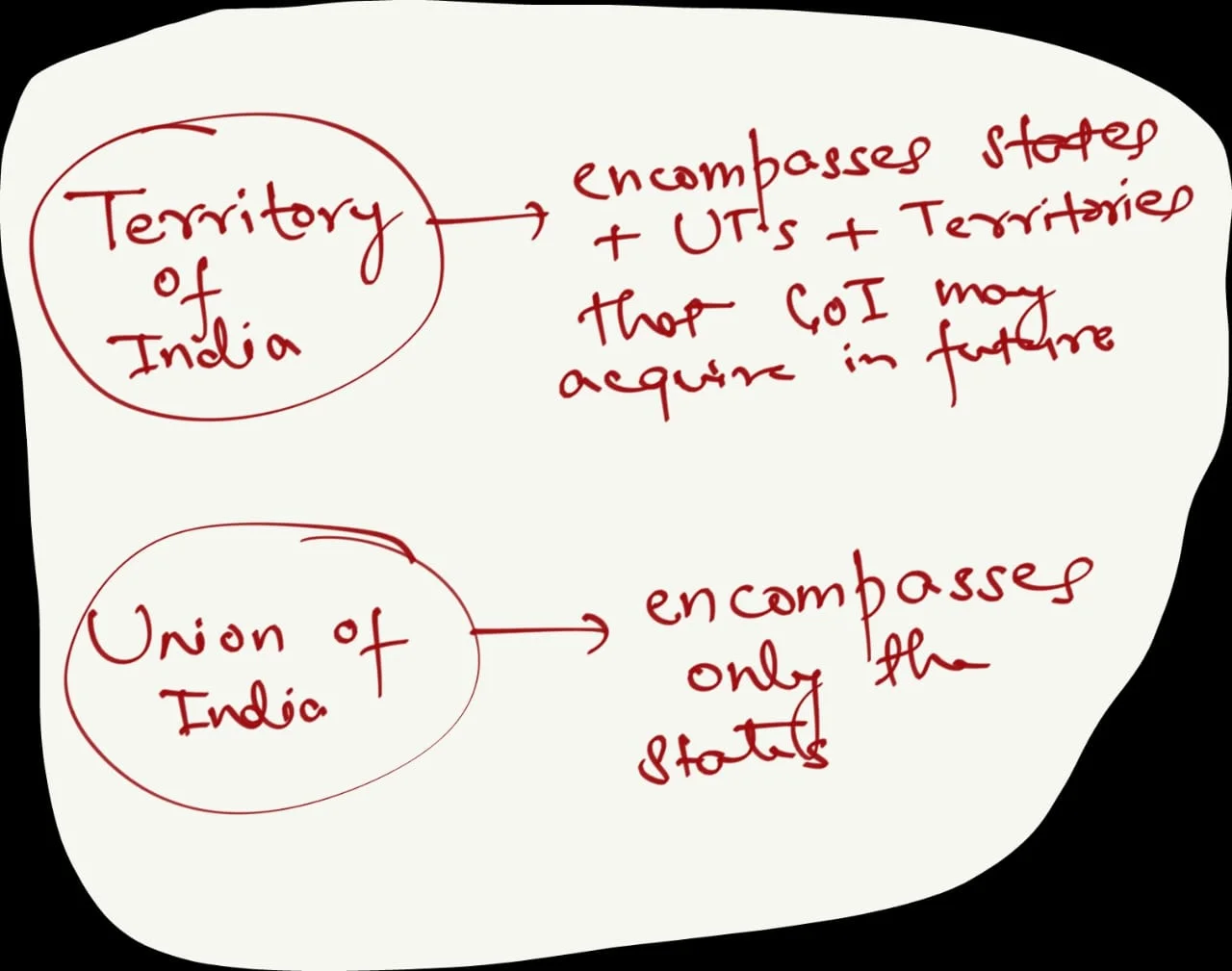At India’s independence in 1947, the country had British provinces and princely states under native rulers. The princely states were given a choice to join India, Pakistan, or remain independent. Most joined India, but Hyderabad, Junagarh, and Kashmir took different paths before being integrated. By 1950, India’s states and territories were classified into four groups, setting the stage for future reorganization.
The Integration and Reorganization of Indian States: From Princely States to Linguistic Identity
Integration of Princely States
- Political Entities at India’s Independence: At the time of India’s independence, the country was composed of two distinct types of political entities:
- British Provinces: which were under direct British rule, and the
- Princely States: which were governed by native rulers but were subject to the overarching authority of the British Crown.

- Choices for Princely States: The Indian Independence Act of 1947 marked the creation of two independent and separate dominions, India and Pakistan, while also providing three choices to the princely states:
- To join India,
- To join Pakistan
- To retain their independence.
- Integration of Princely States: Out of the 552 princely states, 549 opted to join India, while the remaining three states, namely Hyderabad, Junagarh, and Kashmir, initially chose not to join India.
- However, in due course, they were integrated with India through distinct means –
Enroll now for UPSC Online Course
- Constitutional Categorization in 1950: In 1950, India’s Constitution categorized the states and territories of the Indian Union into four distinct groups: Part A, Part B, Part C states, and Part D territories. These totaled 29 entities in all.
Dhar Commission
- Demand for Linguistic Reorganization: The integration of princely states into the broader Indian framework was primarily an ad-hoc arrangement.
- Over time, there emerged a significant demand for the reorganization of states along linguistic lines, with notable emphasis coming from regions, particularly South India.
- Consequently, in June 1948, the Indian government established the Linguistic Provinces Commission, chaired by S.K. Dhar, to assess the feasibility of this reorganization.
- Findings and Recommendations: The commission presented its findings in December 1948, recommending the restructuring of states based on considerations of administrative convenience rather than linguistic factors.
- Formation of the JVP Committee: This recommendation generated substantial discontent, leading to the appointment of another Linguistic Provinces Committee by the Congress Party in December 1948, which was comprised of Jawaharlal Nehru, Sardar Vallabhbhai Patel, and Pattabhi Sitaramayya, and thus informally known as the JVP Committee.
JVP Committee
- JVP Committee’s Report: The JVP Committee presented its report in April 1949 and officially rejected the idea of using language as the basis for state reorganization.
- Creation of Andhra State: Nevertheless, in October 1953, due to prolonged public protests and the tragic death of Potti Sriramulu, a prominent Congress figure, following a 56-day hunger strike for this cause.
- The Government of India was compelled to create the first linguistic state, known as Andhra State, by separating the Telugu-speaking regions from the Madras state.
Fazl Ali Commission
- States Reorganisation Commission: The establishment of the Andhra state heightened the demand from other regions for the formation of states based on linguistic considerations.
- In response, the Indian government appointed a three-member States Reorganisation Commission in December 1953, with Fazl Ali as its chairman and K.M. Panikkar and H.N. Kunzru as the other two members.
- Commission’s Findings: This commission presented its findings in September 1955, acknowledging language as a fundamental factor in state reorganization.
- However, it rejected the notion of ‘one language, one state,’ emphasizing that the unity and security of India should be the primary concern in reconfiguring the country’s political divisions.
Recommendations of Fazal Ali Commission:
- Elimination of the Original Constitutional Classification: The elimination of the original Constitution’s four-fold classification of states and territories,
- Advocacy for New Political Divisions: Advocated the creation of sixteen states and three centrally administered territories.

| Year | Commission | Formed by | Members | Recommendation |
| 1948 (June) | Linguistic Provinces Commission | Government of India | Chaired by S.K. Dhar | Restructuring of states based on considerations of administrative convenience rather than linguistic factors |
| 1948 (December) | Linguistic Provinces Committee (JVP committee) | Congress Party | Jawaharlal Nehru, Sardar Vallabhbhai Patel, and Pattabhi Sitaramayya | Rejected the idea of using language as the basis for state reorganization |
| 1953 | State Reorganisation Commission | Government of India | Fazl Ali as its chairman and K.M. Panikkar and H.N. Kunzru as the other two members | Acknowledged language as a fundamental factor in state reorganization.
However, it rejected the notion of ‘one language, one state,’ |
State Reorganisation Act of 1956
Implementation Through Legislative Acts: The Government of India accepted the recommendations of the Fazl Ali Commission with minor adjustments.
- Through the States Reorganisation Act of 1956 and the 7th Constitutional Amendment Act of 1956, the distinction between Part A and Part B states was abolished, and Part C states were dissolved.
- Some of them were amalgamated with neighboring states, while others were designated as union territories.
- Consequently, on November 1, 1956, 14 states and six union territories were formed.
- Formation New States: The act led to the creation of new states and the Reorganisation of existing ones based on the predominant language spoken by the population.
- It created 14 states and 6 union territories on November 1, 1956, replacing the previous classification of states (Part A, B, C, and D) with the 7th Constitutional Amendment Act of 1956.
- Preservation of Existing States: States that had a common linguistic identity were often retained, but they were sometimes adjusted in terms of boundaries to align with linguistic considerations.
- Example: The State of Kerala was carved out of the former Part B State of Travancore-Cochin with new territories acquired from the State of Madras
- Bilingual States: In some cases, states were declared as bilingual, recognizing that multiple languages might be spoken in a region.
- Example: It merged the Saurashtra state and Kutch state (Gujrathi speaking) into that of Bombay (Marathi speaking) and created a bilingual state of Bombay.
- Promoted the Linguistic and Cultural Identity: This Reorganisation was a significant step in India’s post-independence history, as it recognized the importance of linguistic and cultural identity in governance and administration.
Enroll now for UPSC Online Course
-
- Example: It created the new union territory of Laccadive, Minicoy and Amindivi Islands from the territory detached from the Madras to preserve its cultural distinctiveness.
| Must Read | |
| Current Affairs | Editorial Analysis |
| Upsc Notes | Upsc Blogs |
| NCERT Notes | Free Main Answer Writing |
Conclusion
The reorganization of states became crucial as demands for linguistic representation grew. The Dhar Commission and the JVP Committee initially resisted linguistic-based changes, but public pressure led to the creation of Andhra State in 1953. The Fazl Ali Commission in 1955 further redefined state boundaries, culminating in the States Reorganisation Act of 1956, which reshaped India’s political landscape based on language and cultural identity.
Sign up for the PWOnlyIAS Online Course by Physics Wallah and start your journey to IAS success today!
| Related Articles | |
| Pandit Jawaharlal Nehru | Major Constitutional Amendments: Evolution of India’s Constitution |
| STATES AND UNION TERRITORIES | Constitution: A Living Document |

 GS Foundation
GS Foundation Optional Course
Optional Course Combo Courses
Combo Courses Degree Program
Degree Program












